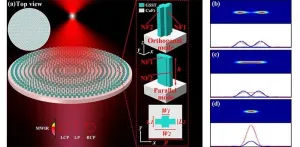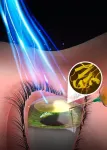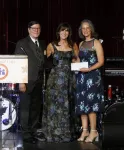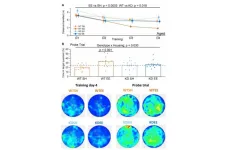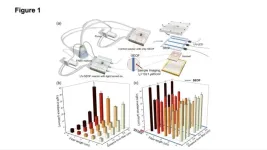(Press-News.org) Precise control of light is a crucial requirement in optical imaging, sensing, and communication. Traditional lenses employed for the purpose have limitations, necessitating more precise and compact solutions. To address this need, researchers have developed metalenses, ultrathin lenses constructed from nanomaterials that are smaller in size than the wavelength of light. These sub-wavelength elements provide the means to manipulate light waves with exceptional precision, facilitating a precise control of the amplitude, phase, polarization, and direction of light waves.
Moreover, compared to bulky lenses, metalenses are easier to produce and are ideal for miniaturized and highly integrated optical devices. However, the sub-wavelength elements also make them susceptible to chromatic aberration. This is a condition where when light passes through a metalens, each wavelength undergoes a different phase shift upon interaction with the sub-wavelength structures. As a result, the various colors or wavelengths of light do not converge at the same point, leading to a loss of focus and reduced image quality.
Now, in a new study published in Advanced Photonics Nexus, researchers have presented a novel approach for creating broadband achromatic and polarization-insensitive metalenses (BAPIML). Their approach leverages the Rayleigh criterion for spot resolution, a fundamental principle in optics used to define the minimum resolvable detail in an imaging system. “The scientific and technical advances reported are notable as they offer a path towards resolving chromatic aberration in metasurfaces, a challenge that has hindered progress in the field,” points out journal editor Professor Alex Krasnok from Florida International University.
According to the Rayleigh criterion for spot resolution, closely spaced point sources can be resolved when the center of the diffraction pattern produced by one point source falls on the first minimum of the diffraction pattern of another point source. When the diffraction patterns approach this limit, the two points become indistinguishable from each other. This principle has been instrumental in designing telescopes and microscopes to distinguish celestial objects and capture the minutest details in tiny specimens, respectively. In this study, the researchers ingeniously applied this concept to develop instead two complementary metalenses that merge the bright spots into a single, focused spot.
They fabricated the two metalenses using nanofins made of a phase change material, Ge2Sb2Se4Te1. These nanofins were arranged in orthogonal or parallel orientations with respect to each other and designed to introduce a phase shift in the light passing through them. One of the nanofins acted as a half-wave plate for a wavelength of 4 µm, while the other served as a half-wave plate for a wavelength of 5 µm.
The metalenses, when illuminated by light, produce two distinct bright spots focused on different positions. However, by carefully adjusting the parameters, such as the radius and focal length of the metalenses, the researchers managed to merge the bright spots into a single focusing spot with an efficiency of up to 43 percent. Simply put, the lenses counteracted chromatic aberrations by focusing light of different wavelengths at the same point.
Finally, the researchers demonstrate the versatility of their approach by generating a broadband achromatic and polarization-insensitive focusing optical vortex. “Put simply, this work signifies that we are on the path towards creating lenses that can better handle light without distortion, and can potentially improve a variety of optical applications,” says Prof. Krasnok.
This new method for developing BAPIML opens doors to a wide range of improved imaging and optical applications, including molecular sensing, bioimaging, detectors, and holographic displays.
Read the Gold Open Access article by Tian et al., “Differentiated design strategies toward broadband achromatic and polarization-insensitive metalenses,” Adv. Photon. Nexus 2(5) 056002 (2023), doi 10.1117/1.APN.2.5.056002.
END
Enhancing image quality with broadband achromatic and polarization-insensitive metalenses
Using novel differentiated design principles, researchers offer a way to eliminate chromatic aberration in metasurfaces
2023-07-25
ELSE PRESS RELEASES FROM THIS DATE:
Study links alcohol-associated liver disease to abnormal cutting and rejoining of molecules
2023-07-25
SAN ANTONIO (July 25, 2023) — Alcohol consumption is a major cause of chronic liver disease. The disease, which has devastating consequences, progresses through stages of hepatitis (inflammation), fibrosis (scarring) and cirrhosis (severe scarring). Advanced disease increases the risk of developing liver cancer, and some individuals may require a liver transplant to live.
Despite a tremendous need for new treatments, the specific biological factors that determine when and how rapidly liver cells deteriorate remain largely unknown.
In a study published May 3 in the journal Hepatology, a research team at The University of Texas Health Science Center at San Antonio (UT Health San ...
Menstrual cups can help prevent infection, improve vaginal health
2023-07-25
Many girls in low- and middle-income countries struggle to buy products to manage their periods, which can cause them to skip school. So, ensuring they have access to menstrual products is critical.
A new Kenya-based study from University of Illinois Chicago researchers shows that the benefits of one kind of menstrual product — a menstrual cup — extend well beyond educational access. Teenage girls who were given menstrual cups were less likely to acquire certain kinds of vaginal infections and were more likely to have a healthy vaginal microbiome, the study found. The findings are published ...
Healing power of light: University of Ottawa team advances clear vision for eye repair
2023-07-25
An injectable biomaterial activated by pulses of low-energy blue light has tremendous potential for on-the-spot repair to the domed outer layer of the eye, a team of University of Ottawa researchers and their collaborators have revealed.
Guided by biomimetic design—innovation inspired by nature—the multidisciplinary researchers’ compelling results show that a novel light-activated material can be used to effectively reshape and thicken damaged corneal tissue, promoting healing and recovery.
This technology is a potential game-changer in corneal repair; tens of millions of people ...
Study offers objective insights to near-miss collisions between drones, airplanes
2023-07-25
Researchers have developed a new way to accurately count and objectively analyze close encounters between drones and airplanes — without depending solely on pilot sightings.
In a peer-reviewed study published by the Society of Automotive Engineers in the “SAE International Journal of Aerospace,” researchers looked at more than 1.8 million piloted aircraft operations and nearly 460,000 flights by small-uncrewed aerial systems (sUAS) around Dallas-Fort Worth Airport, a major hub.
Between August 2018 and July 2021, researchers with Embry-Riddle Aeronautical University and Unmanned Robotic Systems Analysis (URSA) identified 24 near-midair collisions (NMACs) in which ...
Department of Energy announces $4.6 million for research on public-private partnership awards to advance fusion energy
2023-07-25
WASHINGTON, D.C. - Today, the U.S. Department of Energy (DOE) announced $4.6 million in funding for 18 projects at national laboratories and U.S. universities. The awards are provided through the Innovation Network for Fusion Energy, or INFUSE, program, which was established in 2019. The program is sponsored by the Fusion Energy Sciences (FES) program office within DOE’s Office of Science and is focused on accelerating fusion energy development through public-private research partnerships.
“The latest round of INFUSE selections demonstrates the growing interest from private industry in partnering with national laboratories and U.S. universities,” said Jean ...
The Children’s Cancer Foundation, Inc. announces the 2023 CCF Research Awards
2023-07-25
The Children’s Cancer Foundation, Inc. (CCF), a 501(c)3 non-profit committed to funding locally-based researchers, programs and facilities until every child is assured a healthy cancer-free future, is pleased to announce the recipients of the 2023 CCF Research Awards. The eleven pediatric oncology researchers, each conducting work in the Baltimore-Washington region, will be presented with their grants at the 39th Annual Gala to be held November 4, 2023 at Martin’s Crosswinds in Greenbelt, MD.
The 2023 CCF Research Awards, combined with funding for local programs for children fighting cancer, total $1M.
The 2023 ...
nTIDE July 2023 Deeper Dive: Data Uncovers Disparities in COVID-19 Vaccination Rates Among Workers with and without Disabilities in Essential Work Settings
2023-07-25
East Hanover, July 25, 2023 — In a recent study conducted by the University of New Hampshire (UNH) concerning COVID-19 vaccination patterns among “essential” workers, some notable trends have emerged. During the peak of the pandemic, workers with disabilities were less likely to be vaccinated if working in the U.S. Postal Service, food and beverage stores, and correctional facilities. That’s according to experts speaking during last Friday’s nTIDE Deeper Dive Lunch & Learn Webinar.
This ...
MSK1’s required role in cognitive benefits from enriched experiences in old age
2023-07-25
“We show that MSK1 retains its importance in converting positive experience into tangible synaptic and cognitive benefits well into old age [...]”
BUFFALO, NY- July 25, 2023 – A new research paper was published in Aging (listed by MEDLINE/PubMed as "Aging (Albany NY)" and "Aging-US" by Web of Science) Volume 15, Issue 13, entitled, “MSK1 is required for the beneficial synaptic and cognitive effects of enriched experience across the lifespan.”
Positive experiences, such as social interaction, cognitive training and physical exercise, have been shown to ameliorate some of the harms to cognition associated with aging. Animal models ...
New algorithm may fuel vaccine development
2023-07-25
LA JOLLA, CA—Immune system researchers have designed a computational tool to boost pandemic preparedness. Scientists can use this new algorithm to compare data from vastly different experiments and better predict how individuals may respond to disease.
“We’re trying to understand how individuals fight off different viruses, but the beauty of our method is you can apply it generally in other biological settings, such as comparisons of different drugs or different cancer cell lines,” says Tal Einav, Ph.D., ...
Shedding light on a dark problem
2023-07-25
Bacterial biofilms are clusters of microorganisms that form on wetted surfaces virtually everywhere. They harbor pathogens that compromise water quality, and they can disrupt the operation of many different engineered systems through the corrosion, fouling and clogging of tanks, pipes and valves.
In some settings, they could even be deadly. Space suits that enable crew operations outside of the International Space Station use recirculating water to regulate body temperatures in the orbital extremes of full sun (250 F) and full shade (-250 F). But biofilms blooming in those water lines have nearly compromised astronaut safety during ...
LAST 30 PRESS RELEASES:
Tracing the quick synthesis of an industrially important catalyst
New software sheds light on cancer’s hidden genetic networks
UT Health San Antonio awarded $3 million in CPRIT grants to bolster cancer research and prevention efforts in South Texas
Third symposium spotlights global challenge of new contaminants in China’s fight against pollution
From straw to soil harmony: International team reveals how biochar supercharges carbon-smart farming
Myeloma: How AI is redrawing the map of cancer care
Manhattan E. Charurat, Ph.D., MHS invested as the Homer and Martha Gudelsky Distinguished Professor in Medicine at the University of Maryland School of Medicine
Insilico Medicine’s Pharma.AI Q4 Winter Launch Recap: Revolutionizing drug discovery with cutting-edge AI innovations, accelerating the path to pharmaceutical superintelligence
Nanoplastics have diet-dependent impacts on digestive system health
Brain neuron death occurs throughout life and increases with age, a natural human protein drug may halt neuron death in Alzheimer’s disease
SPIE and CLP announce the recipients of the 2025 Advanced Photonics Young Innovator Award
Lessons from the Caldor Fire’s Christmas Valley ‘Miracle’
Ant societies rose by trading individual protection for collective power
Research reveals how ancient viral DNA shapes early embryonic development
A molecular gatekeeper that controls protein synthesis
New ‘cloaking device’ concept to shield sensitive tech from magnetic fields
Researchers show impact of mountain building and climate change on alpine biodiversity
Study models the transition from Neanderthals to modern humans in Europe
University of Phoenix College of Doctoral Studies releases white paper on AI-driven skilling to reduce burnout and restore worker autonomy
AIs fail at the game of visual “telephone”
The levers for a sustainable food system
Potential changes in US homelessness by ending federal support for housing first programs
Vulnerability of large language models to prompt injection when providing medical advice
Researchers develop new system for high-energy-density, long-life, multi-electron transfer bromine-based flow batteries
Ending federal support for housing first programs could increase U.S. homelessness by 5% in one year, new JAMA study finds
New research uncovers molecular ‘safety switch’ shielding cancers from immune attack
Bacteria resisting viral infection can still sink carbon to ocean floor
Younger biological age may increase depression risk in older women during COVID-19
Bharat Innovates 2026 National Basecamp Showcases India’s Most Promising Deep-Tech Ventures
Here’s what determines whether your income level rises or falls
[Press-News.org] Enhancing image quality with broadband achromatic and polarization-insensitive metalensesUsing novel differentiated design principles, researchers offer a way to eliminate chromatic aberration in metasurfaces
